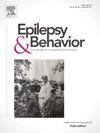Provocative techniques for functional/dissociative seizure: the colored pad test – a safe and reliable procedure
IF 2.3
3区 医学
Q2 BEHAVIORAL SCIENCES
引用次数: 0
Abstract
Introduction
Suggestive seizure induction during video-EEG is a widely used and valuable tool for diagnosing functional/dissociative seizures (FDS). However, there is currently no standardized protocol. In this study, we describe the technical procedure of the induction/suppression test using colored cotton pads applied to the patient’s neck and report our experience with this method over an eight-year period in routine clinical practice.
Methods
We retrospectively reviewed the induction/suppression test performed using the cotton pads procedure in consecutive patients referred to our Epilepsy Centre with suspected FDS between February 2016 and July 2024. The technical details of the procedure are provided. We compared patients with a positive (T+) versus negative (T−) induction test and assessed the rate of patients responding to the suppression phase of the test.
Results
An FDS episode was recorded during the induction test in 82/130 (63.1 %) patients with suspected FDS. T+ patients did not differ from T− patients in terms of sex, concomitant epileptic seizures, history of psychiatric disorders, age at FDS onset, type of FDS, or neuropsychological evaluation results (all p > 0.05). However, T+ patients had a significantly lower level of schooling compared to T− patients (median: 8 vs. 13 years; p = 0.016). The suppression procedure effectively terminated induced FDS episodes in 79/82 (96.3 %) of T+ patients.
Conclusion
The induction/suppression test using colored cotton pads during video-EEG monitoring is a feasible, effective, safe and ethically sound method for achieving a diagnosis of documented FDS.
功能性/解离性癫痫发作的刺激技术:彩色垫试验-一个安全可靠的程序
视频脑电图提示性癫痫诱导是一种广泛使用和有价值的诊断功能/分离性癫痫发作(FDS)的工具。然而,目前还没有标准化的协议。在这项研究中,我们描述了将彩色棉垫应用于患者颈部的诱导/抑制试验的技术程序,并报告了我们在常规临床实践中使用该方法的经验。方法回顾性分析2016年2月至2024年7月间,我们癫痫中心收治的疑似FDS患者连续使用棉垫进行诱导/抑制试验。提供了该程序的技术细节。我们比较了阳性(T+)和阴性(T -)诱导试验的患者,并评估了患者对试验抑制期的反应率。结果130例疑似FDS患者中有82例(63.1%)在诱导试验中出现FDS发作。T+患者与T -患者在性别、伴发癫痫发作、精神病史、FDS发病年龄、FDS类型或神经心理学评估结果方面均无差异(p >;0.05)。然而,与T -患者相比,T+患者的学校教育水平明显较低(中位数:8年对13年;p = 0.016)。抑制手术有效地终止了79/82 (96.3%)T+患者诱导的FDS发作。结论视频脑电图监测中彩色棉垫诱导/抑制试验是一种可行、有效、安全、合乎伦理的诊断FDS的方法。
本文章由计算机程序翻译,如有差异,请以英文原文为准。
求助全文
约1分钟内获得全文
求助全文
来源期刊

Epilepsy & Behavior
医学-行为科学
CiteScore
5.40
自引率
15.40%
发文量
385
审稿时长
43 days
期刊介绍:
Epilepsy & Behavior is the fastest-growing international journal uniquely devoted to the rapid dissemination of the most current information available on the behavioral aspects of seizures and epilepsy.
Epilepsy & Behavior presents original peer-reviewed articles based on laboratory and clinical research. Topics are drawn from a variety of fields, including clinical neurology, neurosurgery, neuropsychiatry, neuropsychology, neurophysiology, neuropharmacology, and neuroimaging.
From September 2012 Epilepsy & Behavior stopped accepting Case Reports for publication in the journal. From this date authors who submit to Epilepsy & Behavior will be offered a transfer or asked to resubmit their Case Reports to its new sister journal, Epilepsy & Behavior Case Reports.
 求助内容:
求助内容: 应助结果提醒方式:
应助结果提醒方式:


